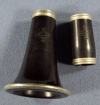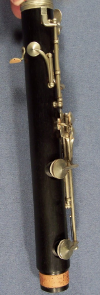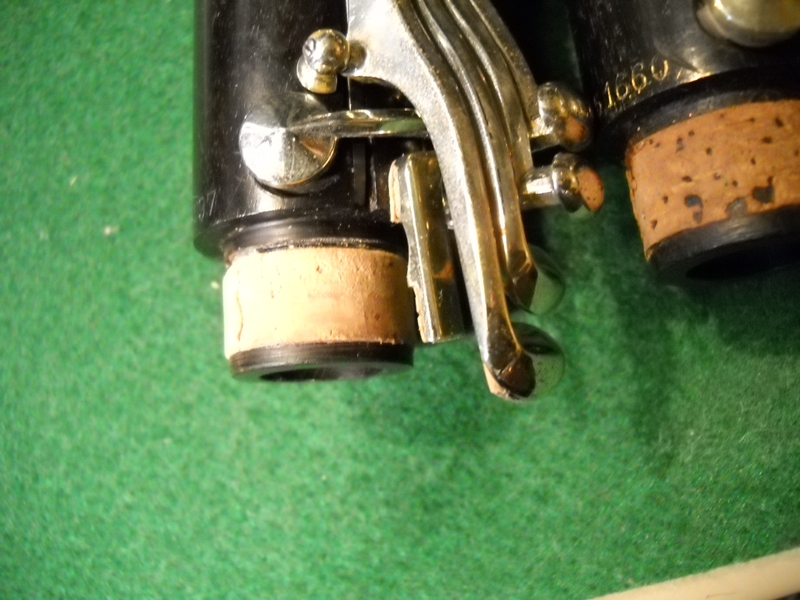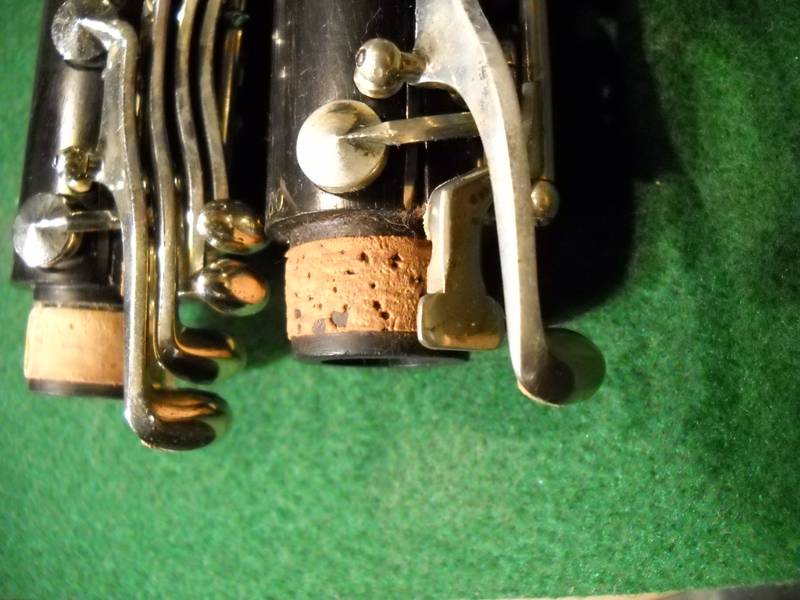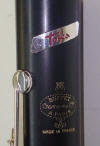Visit me on YouTube at
Visit us on YouTube Clarinet Perfection on YouTube
or email at
gottalovetheknowledge@gmail.com
Quick Links (editing)
pre-1955 (before the “R-13”) History —
Late 1800s
1888 Single Piece Barrel/Upper Joint
rare 1895 Half Boehm
Early Wraparound register key
NB Model
1920s Single Piece Body
1921 Donut Key
1928 Albert
Carl Fischer
“R13” General Models
pre-R13
Academy Model
Olds Opera stencil
Academy v Regular (v E&S) Buffet Analysis
Pre R13 versus R13 identifiers
1950s – early 1990s 1955 R-13 1960s S-1,
BC-20, Continentale 1974 UK Transition
models RC model 1993 DG model
Jazz Festival Elite
Modern: Tosca R13 Vintage R13Vintage
Register & raised C#G#
R13 Prestige
Limite R13
Greenline Festival
RC/RC Prestige
Intermediate: E-11 France E-11/E-11
“A”
C-12 E-45
Clear E-11
Post Evolution Spring Evolution
Throat Key Evolution
Wavy Tenons
November 2012 – Model Changes from Buffet
Buffet Crampon Clarinets
http://www.buffet-crampon.com/buffetcrampon.asp?lang=english
Professional clarinets since 1825, factory established 1850.
This list does not include the Evette model clarinets made by Buffet
http://youtube.com/watch?v=QPWKD-3q1JU
April 3, 2012 – Fondations Capital acquires Buffet Group together
with CDC Enterprises and the management
Fondations Capital announces the completion of the acqisition of Buffet Group for an enterprise value of 58 million euros.
Fondations Capital has completed the acquisition of Buffet Group for an enterprise value of 58 MILLION EUROS, REPRESENTING 7.9 TIMES LAST TWELVE MONTHS ebitda.
Not sure where I got this blurb from, probably Boosey & Hawkes (Buffet is now a separate wholly owned company) ( some this information was forwarded to me via email at one time. A few years ago the owner/tech of WichitaBand.com contacted me – a lot of this verbage is straight off their website. He allowed me to use it – nice guy too. Check out their website they sell many Buffets and other brands and instruments. Alot of information there too as he has been
in the industry for a very long time).
“Buffet History
Founded in 1839 by Jean-Louis Buffet-Crampon, Buffet clarinets soon became the choice of the majority of the world’s professional players. By 1900, Buffet had a workforce of 200 craftsmen, producing clarinets, flutes and saxophones, all of high quality.
Paul Evette and Ernest Schaeffer bought the firm in 1885. “Evette and
Schaeffer” clarinets were the “step up” instruments from Buffet until
about 1980. A public corporation since 1929, the company was absorbed into
the Boosey-Hawkes conglomerate in 1981.
Instruments made between 1935 and 1980 are considered by many to be the
very best of Buffet’s production. The American investor Martin Tolchin
bought Buffet in the mid 1970’s. He was aware of the fact that not all
clarinet players agreed on the tone-color of their instrument, so the
“R-13” (“Arthur King”, we call them…) model was soon joined by the
“Continentale”,
the “S-1”, the “BC-20” and later the “RC”. All have subtle differences,
all are considered to be “top of the line” equals. Before 1980, the Buffet
name was only engraved on their best clarinets: the “step up” and student
quality instruments were stamped “Evette & Schaeffer” or “Evette”. Today,
the Buffet name and logo are engraved on the entire line of Buffet
instruments, from the German-made plastic to their very best clarinetsvin
Buffet is now a part of the Boosey-Hawkes Musical Instrument Company of
London.”
Current Buffet History as taken from the Buffet-Crampon
website
http://buffet-crampon.com/en/history.php
In 1825 a French luthier”, Denis Buffet-Auger,
established his workshop right in the heart of Paris. He quickly became
well-known in the music world for developing of the excellent 13-key
clarinet. At that time, clarinets were entirely hand-made, which required
a wealth of experience and craftsmanship.
In 1830, Jean-Louis Buffet (Denis’ son) took over the
business. He married Zoé Crampon in 1836 and so the
famous Buffet Crampon brand name was created. The logo used today first
appeared in 1844.
Louis-Auguste Buffet (Jean-Louis’ uncle) met the
clarinettist Hyacinthe Klosé, a virtuoso musician and a
teacher at the Paris Conservatory. These two men, the technician and the
artist, worked together. They took the idea of movable rings which the
German Theobald Boehm has developed for the flute and
adapted it for the clarinet. First exhibited in 1839, this new system was
very successful and in order to meet the demand, the Buffet Crampon
factory was built in 1850 in Mantes-la-Ville. As early as 1866, Buffet
Crampon was producing its first saxophones, 20 years after the invention
of this instrument by the Belgian Adolphe Sax.
Buffet Crampon has received many awards for the quality of its
instruments, notably in 1889 during the Universal Exhibition in Paris.
In 1918, Buffet Crampon entered the American market and established its
position as the leader in the world of professional clarinets.
In 1921, a young beginner, Robert Carrée, was hired by
the company. He was an extremely talented acoustic technician and
developed the R13 clarinet in 1950 and the RC clarinet in 1975. These in
turn led to the creation of the Festival and Prestige professional models.
The factory modernizes its workshops and has adopted modern technology,
but remains faithful to its original standards for quality.
In 1981, Buffet Crampon was bought by the famous music publisher Boosey
& Hawkes, of London.
Buffet Crampon has always had a tradition of innovation. In 1994, a new
material was created and named Green Line. This
innovative material is composed 95% of ebony powder and 5% of carbon fibre,
eliminating the risk of cracking while maintaining the acoustic qualities
of wood. Today the Green Line range is used worldwide by the greatest
professional clarinet and oboe players.
In 2003, Boosey & Hawkes withdrew from the famous French manufactory of
instruments, and sold it to The Music Group.
In 2005, Buffet Crampon regained its
independence under the supervision of the President Paul
Baronnat, who is deeply committed to the accompaniment of the
musicians and the protection of the brand. In 2006,
Buffet Crampon acquires two famous brands of brass instruments:
Antoine Courtois Paris and Besson.
Since its inception, the company has ranked first amongst clarinet
manufacturers, owing to its unrivalled expertise, innovative approach and
modernised facilities, from which Buffet Crampon oboes, bassoons and
saxophones also benefit.
The tradition, the spirit of the company and the musicians
accompaniment have been, since 1825, and are now more
than ever the centre of the dynamic of Buffet Crampon.

Not sure where I got these pictures from:
1895 – Half BoehmThis particular Buffet is a rarity.
It’s an Albert but with Boehm bell keys.
Upper Joint
The “ring” keys are pure Albert, but as one can see lack any Rings.
The 4 trill keys look Boehm, but function with Albert fingerings.
The throat keys function like Boehm in that the A lifts the Ab/G# key.
Lower Joint
The bell keys, the Boehm styled pinky keys function just like a boehm.
But the “ring” keys are pure Albert.
and the sliver key is opposite other Buffet Alberts. Normally opens on
the left side of the instrument versus the modern right side such as
this model.


 This early Buffet features the teapot
This early Buffet features the teapot
register vent which is located on the front of the upper joint.
This register key it self is fairly long and winds around the body to
the front.
There is not direct closing action and requires a slightly softer type
of pad. Several keys have the flat spring.

Also note, as below, that that C#/G# tonehole actually is not cut as
the other toneholes but simply a hole in the cylinder – the surface is
curved to the cylinder. You can use a leather pad for sealing or
a cork pad. With a cork pad one simply holds some fine grit
sandpaper on the body (grit facing out) and then carefully sands down
a cork to the body curvature .. works pretty good. Of course,
one can always cut a proper tonehole too.
This 1909 enhanced boehm version has the simplified articulated C#/G#
mechanism, very similar to the way a saxophone uses the G#.
Imported by Carl Fischer.
1918This particular 1918 1Lxxx clarinet with
a wraparound register key has the marking “NB” underneath the Buffet
emblem.
No idea what NB stands for
 1920ssingle piece body, full boehm
1920ssingle piece body, full boehm
pic courtesy of Junkdude.com
Picture 1
Picture 2
Picture 3
Picture 4
Picture 5
Picture 6
Picture 7
In the 1921 era Buffet came out with a
novel design at an attempt to improve tone to upper joint ring tones.
They came up with the “donut” clarinet. A very perplexing
solution and the design quickly was removed from the market.
These pictures are of a xxxN1 Bb and A set. I have found a N3xx
donut sample but I think there is too wide spread of the date of
manufacture and the N3xx would have a “1” preceeding it, which would
pit in in 1921 too, instead of 1900


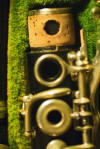
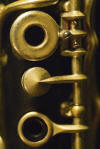
xN318 to the right
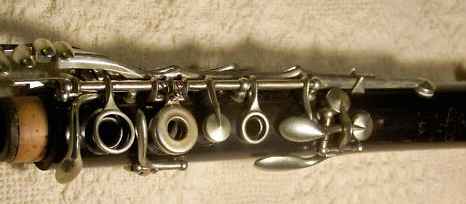
1925 – 1S6xx Notice the wraparound
octave key and no adjuster yet on the Ab throat key
1926per the serial number this is a 1926 Buffet. Albeit
quite dirty.
This 1928 Albert you can see that most keywork is sprung with flat
springs, also the screws were inserted into a hole that went all the
way through the touchpiece and then sanded down smooth. Sorry
about the pics – my camera broke and the replacement was a dud.
Also in 1928 Buffet changed their serial number system.
From the number/letters.number to a incremental number.
1910-1930s1910-1930s Buffets were imported by Carl Fischer and
had an appropriate designation to that. Any “LP” stamp
designated Low Pitch at 440hz This 1930 Enhanced Boehm has some interesting mechanisms on it.
Notice the middle tenon has 2 holes in it. The top one is for
the LH pinky C#/G# and the lower one is the the RH C#/G# which is a
wholly separate mechanism from the other one. Introduction of
the Adjustor on the Ab throat key.

 This
This
is the normal inline tenon tonehole


 Here
Here
is the offset Right Hand C#/G# tenon tonehole
Upper joint pictures. The trill Bb key is not original


Lower Joint pictures. The alternate Eb is an interesting
design




1934This example is of a 161xx clarinet from
1934. Notice the single post for the lower joint left pinky
spatula keys. This design is stopped around 1936 and uses an
individual post for each C# & B keys. Notice: No adjustor
on the Ab throat key 1935This 1935 clarinet, sn 184xx. This
particular model has an extra vent on the upper joint which is closed
with the 3rd ring or the sliver key.Notice: No adjustor on the
Ab throat key even though it was on the 1930 model above.
1936ishkeywork modification when the [a] LH pinky
spatula keys went from 1 shared post to two posts and rodsBelow
shows also shows [b] and 2
horizontally placed screw thumbrest (see pics of 1936 in SN list
#18450)
This is another interesting 1936 Buffet – notice the upper 3rd ring as
it also activates a secondary vent that the sliver key does not close.
Compare that to a model that has an articulated C#/G# for the LH pinky
only.
The articulated mechanism is on the lower joint which includes a metal
socket.
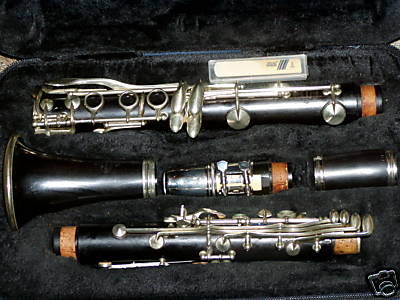
This 1936 regular boehm (sn 2190xx) is what we are accustomed to,
except for the throat key adjustor

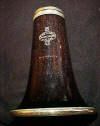


pics courtesy Junkdude.com (if you’ve been watching there’s no
adjustor on the Ab throat key yet)
picture 1
picture 2
picture 3
picture 4
picture 5
1939 sn 26xxx, Yes, and finally the Ab throat key Adjustor is a
standard option
Notice the shape difference of this trill key sheet metal guides
versus the pre-R13 pic below
1941-1950Carl Fischer Musical Instruments Company of New York
continued to import the Buffet clarinets. They (Carl Fischer and
not Buffet) had
the designations of R13, R13 1/2, R14, R14 1/2, R16 R16 1/2, R16 3/4 –
this was found in the Carl Fischer catalogs, not on the clarinet
itself.
The “1/2” represented an Eb lever.
The R14 had 17 keys and 7 rings & the Eb lever.
R16 was the 19 key, 7 ring with articulated G#, Eb lever and forked Eb
key.
R16 3/4 had 20 keys, 7 rings, articulated G#, Eb lever, forked Bb and
a partridge in a pear tree !!These identifiers were basically used
to differentiate the instrument itself. But an R13 was still
considered an “R13” PLUS options to the consumer. pre R-13Pre-R13s Stopped production around 1955. Visual
attributes: Shared throat post keys; key guide for top two trill keys
is a flat metal with triangular sides.From at least 1941 – 1955 Pro
Buffets had a new “Master Bore”. During the 1950-1955 time frame Carree’s polycylindrical
bore was used experimentally and evolved towards the introduction of
the R-13 in 1955.
Models from at least 1951 onwards had a tapered
“Master Bore” bore. ex: sn 41xxx
Earlier models had a cyclindrical bore. ex: sn 38xxx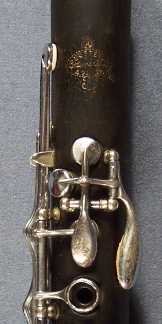 This example, 485xx has a barrel trill key guide.
This example, 485xx has a barrel trill key guide.
Thus not all pre-R13s have the flat sheet metal trill key guide.
This 485xx has a pre-R13 bore thus has all the tonal characteristics
of a pre-R13.







Pre-R13 versus R13 key identifiers
THROAT POST KEYS
BELOW: On the left is an Pre R13 on the right is an R13.
The preR13 shares one post for the throat keys, as the R13 has all
separate posts.
This allows the R13 to have a longer and stronger spring the the Ab
key.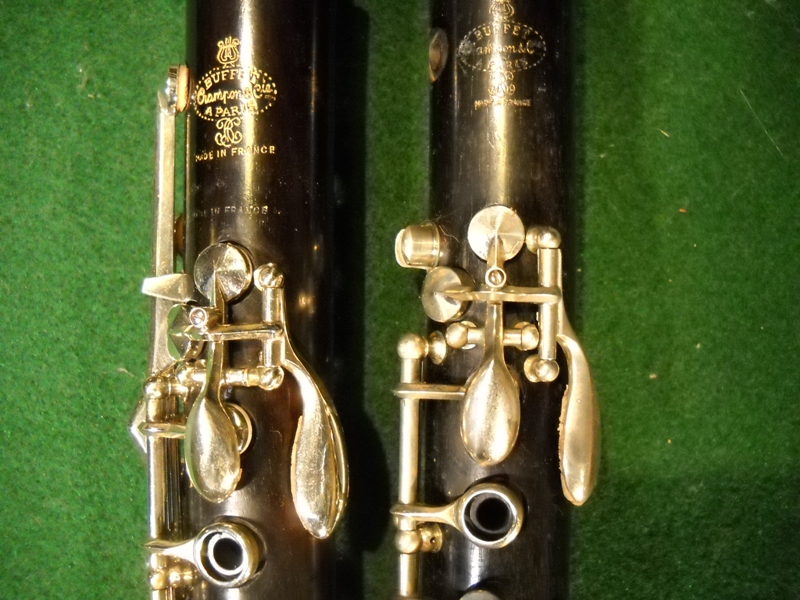
SHEET v cut Barrel Trill Key Guides
BELOW: PreR13 on the left, R13 on the right.
Notice the PreR13 is triangular but more importantly is folded from a
flat piece of metal.
The R13 is a barrel with a slot cut through it for the keys.
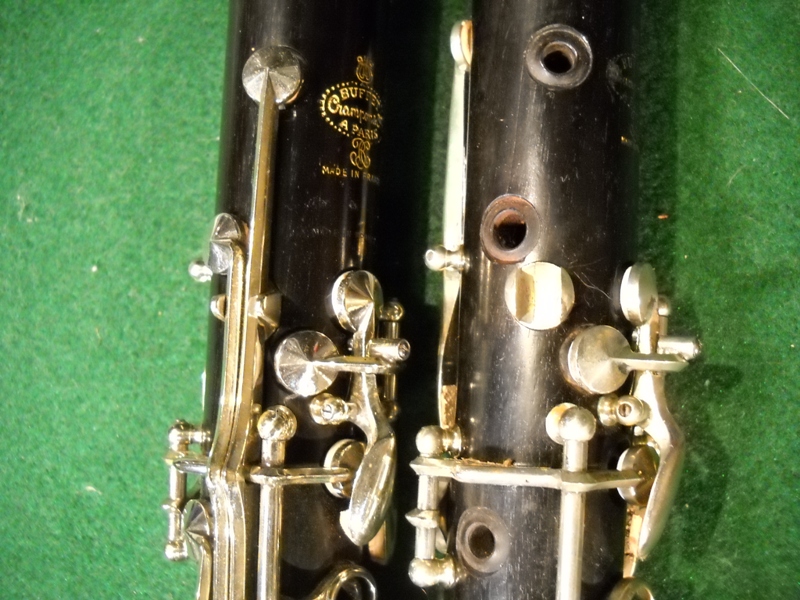
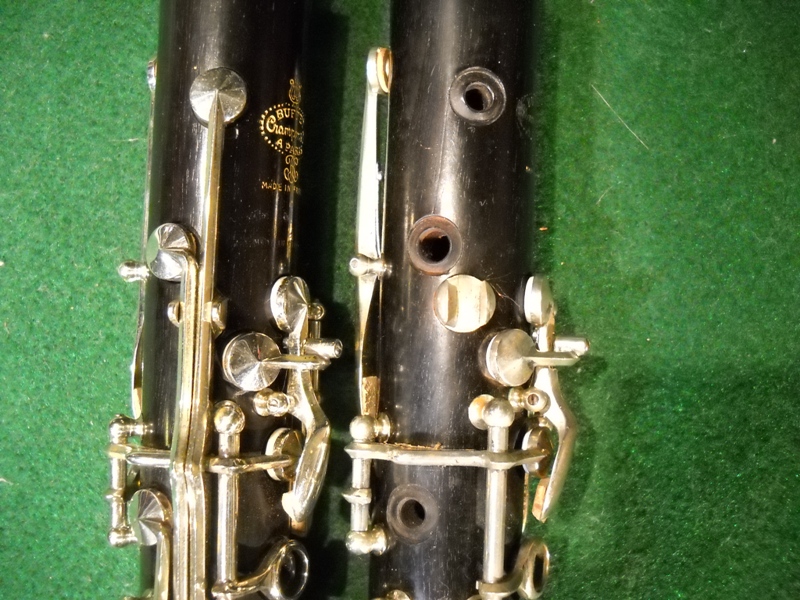
BRIDGE KEY
BELOW: On the left is a Pre-R13, on the Right is an R13.
Notice the “wings” on the R13.
Started Production in 1955 through today.
Some “prototypes” were developed earlier than 1955. Primary
identification included separate throat key posts; shape of the key
guide for the top two trill keys – R-13 has a cylinder with slot cut
down the middle.
Current Model Numbers:
Bb R13 nickel silver keys Model: BC1131-5-0, 2011 Retail Price $
4,605
Bb R13 silver plated keys Model: BC1131-2-0, 2011 Retail Price
$5,205
Bb R13 Greenline silver plated keys Model: BC1131G-2-0, 2011
Retail price $5,205
Bb R13 Greenline nickel plated keys Model: BC1131G-5-0, 2011 Retail
Price $4,605
A R13 silver plated keys Model: BC1231-2-0*, 2011 Retail Price
6,205
A R13 nickel silver keys Model: BC1231-5-0-462813, 2011 Retail
Price $ 5,605
A R13 Greenline Model: BC1231G-2-0, 2011 Retail Price $
6,205
Eb R13 silver plated keys Model: BC1531-2-0-462801, 2011 Retail Price
$ 6,130
Early R13s has a flat spring for the C#/G# key until,
supposedly 1970. To some, this provides a much smooth key
action. This was the preferred method going back to the earliest
Buffets but was not used in the 1940s – mid 1950’s – as a needle
spring was used.We offer a
service where we can retrofit a flat spring to the C#/G# key for those
that prefer it (the needle spring can be unhooked and kept in position
if desired)
The R13 from
1955 through 1970 register vent was smaller and higher than current
production. These earlier models are considered to have the best sound
of any era R13 but at the cost of a thin/stuffy throat Bb and also
quirky tuning of the 12ths. A reverse conical barrel (Moenning
type) can improve the tuning.
In 1970 the register vent was lowered and enlarged. This greatly
improving the throat Bb (especially if resonance fingering is
used [ ie, the left and right ring fingers and the right little finger
low F key). The tonal quality essentially became less but more
powerful.
http://test.woodwind.org/clarinet/BBoard/read.html?f=1&i=299692&t=299692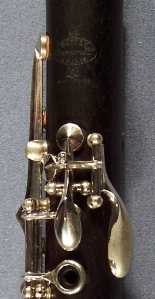

 Academy
Academy
R113R113s were also known as the Academy model which were
supposedly identical to R13 with some minor default such as body or
key scratched.Apparently the Buffets from 38,000 through 41,000
were designed with a lower joint a bit too large. This created a
problem with clarinetists playing the instrument in tune and Buffet
was losing business. Buffet brought in Hans Moenig who some how
corrected the faults and these instruments were relabeled as an
Academy model and sold as a student model.
But there are some
Academy models which resemble the R-13. The serial numbers above
are Pre-R13. They exist in both eras
But many Evette, Evette
Master Models, Evette-Schaeffer and Evette-Schaffer Master Models are
Malerne stencils.
Any with a preceeding A, B, C, D or E are Malernes. any K series
are Buffet made. There are few that are just a number, within
the R13 range that are R13 defects, but only a few – they must have
totally identical keywork, totally identical body cutouts .. ie,
totally identical !!As you can tell from the keywork, this is
an “R-13” Academy


 “L” shaped keywork and sn# to match,
“L” shaped keywork and sn# to match,
Master Bore (pre-R13) Academy model sn38xxx




![]()
 Olds OperaThe
Olds OperaThe
Olds Opera was considered one of the few Buffet stencils this late.
There are other Buffets stencils from years past, mostly Albert style
keywork, but few actual Buffet made stencils.
This Olds Opera was considered a stencil. If it truly is then
it is one of those serial numbers where it has the shared throat
posts, and the barrel style trill key guide which would put it in the
485xx serial number range. This one is obviously a Pre-R13
stencil due to the throat keys sharing a post.
/cl01.jpg) Academy model sn 42842
Academy model sn 42842
versus a regular Buffet sn 42597 (below a E&S)As luck may have it we
have two model Buffet clarinets. A standard professional Buffet
with a serial number of 42597 and an Academy model sn 42842, roughly
245 clarinets separating these two virtual twins in manufacturing.
The third one in the Blue Felt is a 38xxx Academy.
We will be adding much more information including bore analysis,
tonehole locations and diameters, keywork (yes, look at the cutouts on
the ring toneholes that do not exist on the Academy model) but to wet
your whistle until then here is a picture of the two upper joints.
What is visually obvious, and confirmed with some quick measurements,
is that the toneholes on the Academy model are quite a bit smaller
than on the regular Pro model. More to come later but here are
the twins:
NOTE: I added from an archive photo a different Buffet Academy sn
38xxx – it has the ACADEMY stamps in different designs (yes, the
picture seems warped).

On the above top picture look at these items: The “made in france”
is double stamped on both models in two locations on the upper and
lower joint. The Academy has the Academy Model stamp over one of
the made in “Made in France” stamps. The Blue felt cased Academy looks
different from the “twin” ones. The toneholes look more “normal”
sized.
All the toneholes are smaller on the Academy. First look at
the top cup key – just below the throat keywork, that one is painfully
visually obvious in size difference. But they are all smaller.
The bore is interesting. The Academy bore is larger than the
regular model, with step points further down. It’s like the bore
tool accidentally was pushed too far into the wood while boring out
the bore. And thus to compensate for balanced resistance they cut out
smaller toneholes. I wonder if this was a consistent
“inconsistent” boring problem, such as one something/someone slips up
every so often.
The smaller toneholes make the academy model more centered and
easier to play (in a slight resistance sort of way). The smaller
toneholes throughout the entire instrument makes coverage easier for
smaller, younger fingers. The Academy model seems to be more of
an intermediate instrument. We just have to wonder if it was by
accident or by design.
Virtually all the tonehole locations are identically positioned.
The diameter of the toneholes though are much smaller on the Academy
than the regular Pro model.
Also the register vent location on the Academy is .75mm further
down the clarinet body and a larger diameter by .2m. It may not
seem like much but it is easily measurable. Using the smaller
diameter Pro register vent on the Academy tonally really makes it
stuffy especially the throat notes and causes a minute air stream
issue when jumping 12ths (using and not using the register vent).
| Register key | Buffet Pro 42xxx | Academy 42xxx | Academy 38xxx |
| Distance from top of joint (excluded tenon) | 18.75 | 19.5 | 19.75 |
| diameter | 2.55 | 2.75 | 2.75 |
| Entry bore (top) | 14.78 | 14.88 | |
| Exit Bore (bottom) | 14.61 | 14.73 |
All the numbers, above and below are of the middle of the tonehole.
The toneholes on the Buffets are hourglass shaped.
I also have the overcut size but all the numbers can get quite
confusing to look at and the middle of the tonehole
seems more accurate. Measuring and overcut can be inaccurate.
Unfortunately the Academy 38xxx was
several years ago and was the 2nd clarinet where I did full
measurements on and I found out it is easy to “oversize”
anything with even high quality digital calipers – one has to have a
very light & accurate touch. Thus the
Academy 38xxx may be overstated.
| UPPER JOINT | Buffet Pro 42xxx | Academy 42xxx | Academy 38xxx |
| KEY | diameter | diameter | diameter |
| 1st trill | 4.69 (all in mm) | 4.42 | 4.85 |
| 2nd trill | 5.48 | 4.76 | 5.45 |
| 3rd trill | 4.55 | 4.64 | 4.9 |
| 4th trill (Bb) | 5.9 | 5.26 | 5.77 |
| throat A | 5.08 | 4.46 | 4.9 |
| Throat Ab | 5.05 | 4.55 | 4.25 |
| F | 4 | 4.1 | |
| top ring | 4.6 | 4.86 | |
| 4.05 | 4.5 | ||
| 2nd ring | 6.7 | 6.85 | |
| C/G | 6.95 | 7.1 | |
| sliver Bb | 5.4 | 5.45 | |
| C#/G# | 4.74 | 4.8 |
and to further complicate the matters here’s an Evette &
Schaeffer which is obviously a Buffet just restamped E&S
(pictures from eBay, April 2013, sn # 395xx, 1950)
Continentale
BC-20
The American investor Martin Tolchin
bought Buffet in the mid 1970’s. He was aware of the fact that not all
clarinet players agreed on the tone-color of their instrument, so the
“R-13” model was soon joined by the “Continentale”, the
“S-1”, the “BC-20” and later the “RC”. All have subtle differences,
all are considered to be “top of the line” equals. Before 1980, the
Buffet name was only engraved on their best clarinets ( this
information was forwarded to me via email at one time. A few
years ago the owner/tech of WichitaBand.com contacted me – alot of
this verbage is straight off their website. He allowed me to use
it – nice guy too. Check out their website they sell alot of
Buffets and other brands and instruments. Alot of information
there too as he has been in the industry for a very long time).The BC-20 was
produced from the mid 1960’s until 1987/88 until a design evolution
created the RC model. The BC-20 uses larger toneholes for
improved ease of dynamics (see design characteristic excel spreadsheet
comparing multiple Buffet, Selmer and Leblanc clarinets).
These
clarinets were manufactured from the 1960s through about 1985.S-11970s. R-13 with a inverse taper barrel for a
slightly brighter sound. Recognizable by the S1 in a diamond below the
Buffet emblem. The S1 also had less undercutting for the
toneholes.sn 127230, 1973
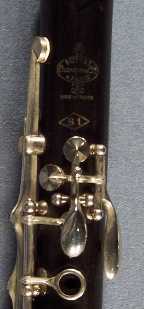
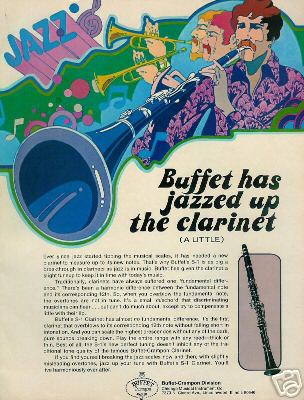 ContinentaleThe American investor Martin Tolchin
ContinentaleThe American investor Martin Tolchin
bought Buffet in the mid 1970’s. He was aware of the fact that not all
clarinet players agreed on the tone-color of their instrument, so the
“R-13” model was soon joined by the “Continentale”, the
“S-1”, the “BC-20” and later the “RC”. All have subtle differences,
all are considered to be “top of the line” equals. Before 1980, the
Buffet name was only engraved on their best clarinets
 BC-20The BC-20 is the more “powerful” of the models. This model
BC-20The BC-20 is the more “powerful” of the models. This model
design has larger toneholes then the equivalent R-13 which allows a
more fuller and dynamic ease of playing. (see design characteristic
excel spreadsheet comparing multiple Buffet, Selmer and Leblanc
clarinets)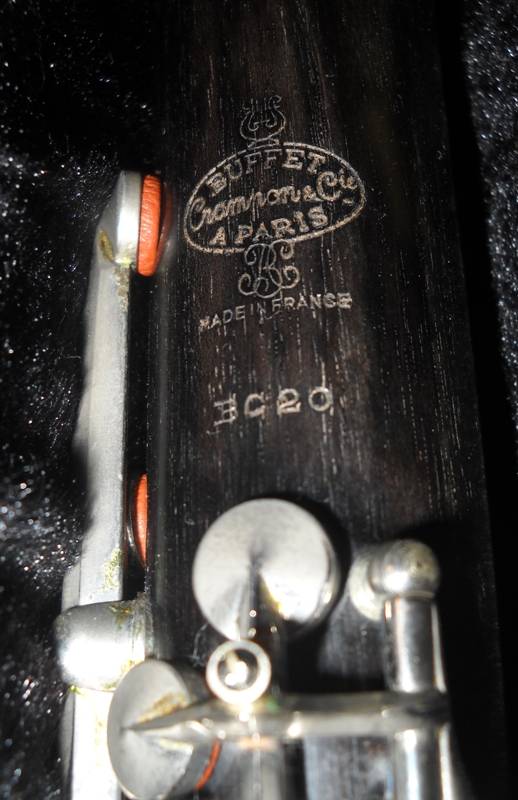
1974
– 1975 Transition In 1974 Buffet
transitioned away from the S-1, Continentale, and BC-20 models to a
more modern lineup which consisted of the long running R-13 and RC.In the UK (United Kingdom, England) some models showed up with a “UK”
stamp. And oddly one particular R13 had a B prefix
(B)143xxx Bb as: R 13 Am?rique 17/01/74
144xxx A as: La Am?rique 18/02/1974
The 2nd picture on the right is from ClarinetDirect.biz and shows
and “A” (on the right” with a UK stamp. Clearly shoved between
the S1 stamp the the throat key.
Chris P in the UK, a superb clarinet tech, also stated that “I
worked on a friend’s R13 from the mid ’80s which had a top joint
transplant carried out at the B&H factory in London. How could I tell?
The serial number was stamped on the top joint above the speaker bush
like it is on B&H clarinets and the number stamps used were the same
style (font or whatever) as B&H clarinets instead of by the C#/G#
tonehole or with the more decorative style number stamps Buffet use.”
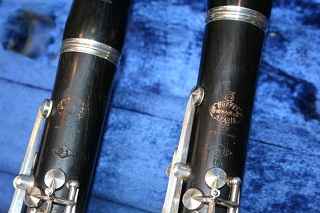
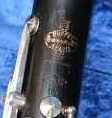 RC
RC
The RC was originally released in 1975.
A modern
definition from the 2012 Buffet website “The
RC clarinet lives up to musicians expectations and gives them great
freedom of expression.
Developed in 1975 by the extremely
talented luthier Robert Carrée, who plays an important role in the
history of BUFFET CRAMPON, the RC clarinet has a pure, sweet sound.
The exclusive design of the RC bore results in easy response and a
homogeneity in all registers. This clarinet, which also has great
stability, has won over innumerable musicians throughout Europe.”
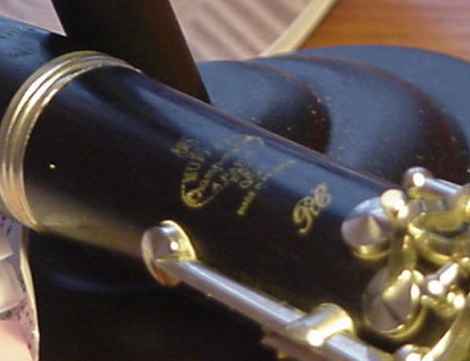 DGDG stands for Daniel Gautier. Mr. Gautier (a top
DGDG stands for Daniel Gautier. Mr. Gautier (a top
Parisian clarinetist) developed this clarinet which was produced from
1993 to 2000 and came in Bb (model 1141AG) and A (model 1241AG).
The bore dimension was 14.62mm which is very slightly smaller than the
respective aged Festival (at 14.64mm).The DG was made with unstained African Blackwood, metal rings on
the tenons, a new design ring keys which were flatter (aka Selmer
like) and adjustable thumbrest. The Lower tenon bore is 14.62mm
but the upper bore is more RC like. This gives it a fairly large
flair from top to bottom of the upper joint. Coupled with a
higher speaker tube design like the RC (about 4mm higher than a R13)
and smaller diameter gives is a unique tone which is brighter and more
expansive than a regular R13.
from eBay there was a barrel
identified as a “DG” barrel which had a cut in the barrel.
Unsure why this was implemented, if this is in fact a factory barrel. E-13
E-13
(High end Intermediate)pre E-13s (before they were sold as Buffets) are
Evette-Schaeffer and Evette clarinets – please see that section for
more information. E-45
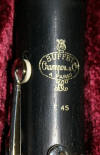 C-12
C-12
(Conservatory/High end Intermediate) LimiteA store marketed brand (Brooke Mays, Caldwell Music of
the US) of the E-11 with a cheaper plastic thumbrest, soft sided case,
silver plated keys.Recognizable by “Limite” in script below the
Buffet emblem. The Limite has a “K” series serial number, just
like the vintage and sought after K series Evette-Schaeffer.
Different emblems entirely but just something to remember.

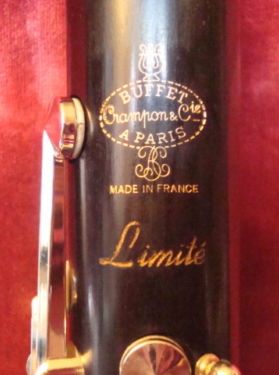 E-11 France
E-11 France
(“Performance” ntermediate)
Made in France
The Buffet Group (2012) which owns
Shreiber (2011) and other companies shifted production of the Shreiber
“made in germany” E11 to france and now call it a Performance Model.
The “E-11 France” model is clearly marked whereas all previous E-11
are not marked “made in France” under the main upper joint emblem.
All previous E-11s are made in germany, whether marked made in germany
(in US a law for original) or not marked (such as ones made for the
european market).
 E-11Made in Germany. Current E-11s have plastic
E-11Made in Germany. Current E-11s have plastic
tonehole insertsThe E-11, an earlier model is identified by the
stamp on the wood of the E-11. Later ones have the foil labels.
The earlier ones are also nickel plated keywork whereas laters ones
are silverplated keywork. The earliers ones also have the buffet
stamp on the barrel and the later ones do not seem to have this.
The Early E-11 “A”s share the same design as the later ones
including the long register vent. The earlier ones also seem to
have much more harmonics in the tone and allow much easier
colorization.


 To the right is a 1,xxx,xxx E-11 “A” Clarinet.
To the right is a 1,xxx,xxx E-11 “A” Clarinet.
Notice the extra long register tube going into the bore. And
also notice the long register tube coming out of the body. The
E-11 “A”s even the earliers ones play extremely nicely when properly
set up. They do not have a “ring” as the R13s do but are very velvety
playing instruments. The earlier E-11 “A”s in a test taht I did
after setup seems to have more color in the tone, much more harmonics,
whereas the later ones are more clearer tonally.
![]()

Clear E-11Not many were made but a few E-11 and B-12s were
produced that were clear and had lacquered or brass keys.
Approximately 1989.
Olds Opera &
Lintonsupposed R-13 stencils (or Master Models) from the 1960s and 1970s. BUT
since this really can’t be proven they really don’t sell for much. Jazz Festival
Serial Number if 33319x puts this example at approximately 1990.
BARREL
The Barrel is very interesting. The top of the barrels bore is 16.22mm
– .639″ and the bottom is 15.09mm – .5945″ with the bore being .5835″
BODY
The body is apparently the same R-13 body. Just with a different barrel
and bell.
Notice the body cutouts for the right hand spatula keys to keep the keys low
to the body (5th and 6th pics)
BELL
The bell is very light, seems like it is made of balsa wood. Other than
the weight, the top part of the bell has a concave section in it (3rd pic)
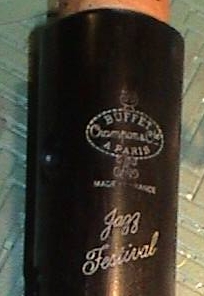 Buffet EliteManufactured from the 1980s through 2002. Thin wall
Buffet EliteManufactured from the 1980s through 2002. Thin wall
body made of a premium grenadilla. The reinforcing rings were made of
black polycarbonate fiber. It was supposedly designed for
“chamber” settings and not orchestra or concert band settingyou can see more pictures of the Elite here
http://www.clarinetperfection.com/clAltKeywork.htm
(pics taken from German eBay)
Special keywork. Notice the “open” hole just above the bell.
And the extra keywork from the top of the register key going all the way
down the lower joint
Built with Gold plated posts and silverplated keywork.
If
you look closely there an open hole on the left as a vent
Take
a close look at the register key, the pad cup. It activates a long
actuating arm which has it’s own bridge and continues to the lower part of the
lower joint.
You
can see the rod keywork alongside the bottom of the lower joint. It ends
and the padcup goes along the backside.
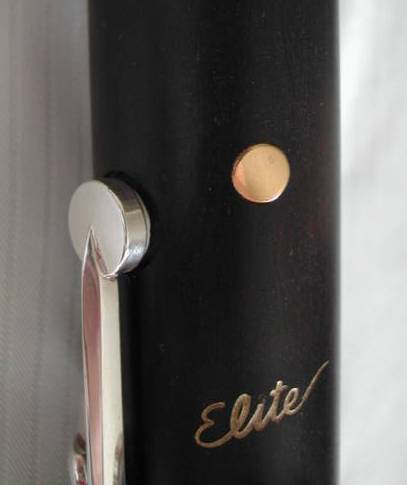 B12 (brushed)Very lightweight brushed plastic, great for beginners.
B12 (brushed)Very lightweight brushed plastic, great for beginners.
Made in West Germany and the quality is unmatched for a student
instrument. Excellent keywork, fit and finish. B12 (polished) Evettepredecessor to the B12 – separate throat key posts,
triangular trill key guide an a large Evette emblem on a plastic body R13 GreenlineBb Model: BC1131G-5-0 (nickel) / Model:
BC1131G-2-0 (silver plated), 2011 Retail Price $4,605.00
(nickel keys) / $5,205.00 (silver plated keys)
A Model: BC1231G-2-0, 2011 retail price of $6,205.00,
wwbw.com description of the Greenlines
clarinetists or any player who is subjected to extreme conditions.
Buffet Crampon R13 Greenline A Clarinet
The Buffet R13 Greenline A clarinet follows the same manufacturing
process as the 100% grenadilla R13s. Thanks to the addition of
carbon fibers, Buffet’s Green Line clarinets withstand to variations
in atmospheric conditions (temperature, humidity).
History
Created in 1994, the Greenline series of instruments has taken
advantage of the excess wood remaining from the clarinet
manufacturing process. This process of combining grenadilla powder
with polycarbonate fiber and epoxy resin produces a clarinet that is
greatly resistant to environmental change and helps to relieve
stress on the African grenadilla wood population.
- Level: Professional
- Key: A
- Body, Barrel, and Bell Material: Green Line made of 95%
grenadilla powder and 5% epoxy resin - Key Material: Silver-plated
- Key System: Boehm (French)
- Tone Holes: Undercut
- Bore Shape: Polycylindrical
- Bore Size: .576″ (14.64mm) <– A
- Pads: Double fish skin
- Springs: Blue steel
- Includes: case, mouthpiece, ligature, cap, and care products
- Crafted In: France
Level: Professional
Key: Bb
Barrel, Body, and Bell Material: Greenline (95% grenadilla powder, 5%
polycarbonate fiber and epoxy resin)
Keys: Nickel-plated
Key System: Boehm (French) / 17 Keys
Tone Holes: Undercut
Bore Shape: Polycylindrical
Bore Size: .574” (14.58mm) <–
Bb
Barrel: 66mm cylindrical
Pads: Double fish skin
Springs: Blue steel (French)
Includes: Deluxe case, mouthpiece, ligature, cap, and care products
Crafted In: France
Though the Greenlines do exhibit a less likelihood of cracking they
still can and do crack. Thus care still has to be taken with the
Greenlines.
The Greenline is identifiable by a green dot on each piece, barrel,
upper joint, lower joint and bell. Luckily this dot is inside a
small routed out circle so if the paint wears off the dot impression
still exists.
R13 VintageBb Model: BC1131V-2-0-462811, 2011 Retail Price $6,105.00
A Model: BC1231V-2-0, 2011 Retail Price $6,800.00
from wwbw.com
Buffet Crampon R13 Vintage Professional Bb Clarinet
The Buffet Vintage R13 Bb Clarinet produces a pure, focused sound that is
unmistakably Buffet. Many elements were utilized on the Vintage that are not
found on the modern R13. Several tone hole placements have been adjusted to
improve tuning, and the bell is 1mm longer producing a very fluid clarion
register. Features include full grenadilla wood body, silver-plated keys,
adjustable thumb rest, and two barrels (one cylindrical, one reverse taper).
Musicians of all kinds will love the Buffet R13 Vintage as it is extremely
flexible, centers easily and projects well in almost any hall. History of the
Vintage R13
In 1996, during a tour of the US and Canada, Rene Lesieux, Buffet’s Research and
Development Manager, fielded many requests from players who wanted a clarinet
with the same feel and sound quality of the 1950’s R13s. The result is a
clarinet that has a great scale, a fluid sound and better response and sound
emission.
- Level: Professional
Key: Bb
Barrel, Body, and Bell: Hand selected grenadilla wood
Keys: Silver-plated
Key System: Boehm (French) / 17 Keys
Special Keys: Eb Lever
Tone Holes: Undercut
Bore Shape: Polycylindrical
Bore Size: .571″ (14.50mm)
Barrels: 1 grenadilla cylindrical, 1 grenadilla reverse taper
Pads: Double skin
Springs: Blue steel (French)
Includes: Leather pochette-style case, mouthpiece, ligature, cap, and care
products
Crafted In: France
- Level: Professional
- Key: A
- Barrel, Body, and Bell: Hand selected grenadilla wood
- Keys: Silver-plated
- Key System: Boehm (French) / 17 Keys
- Special Keys: Eb Lever
- Tone Holes: Undercut
- Bore Shape: Polycylindrical
- Bore Size: .571″ (14.50mm)
- Barrels: 1 grenadilla cylindrical, 1 grenadilla reverse taper
- Pads: Double skin
- Springs: Blue steel (French)
- Includes: Leather pochette-style case, mouthpiece, ligature, cap, and care
products
The Vintage was designed to capture the tonal quality of the 1950s
Buffets. They did a wonderful job of accomplishing this. The
Vintages sound so identical to the 1955s that I own except they have less
resistance.
Per Buffet Crampon website
“A highly colorful clarinet!
The Vintage clarinet was designed in 1996 by René Lesieux, master craftsman
and responsible for instrument research and development at Buffet Crampon for
over 40 years.
In creating the Vintage, Buffet Crampon especially wanted to satisfy those
musicians who wish to find the same features and sound they had with their
1950’s R13 clarinet.
Today, the Vintage has charmed many clarinettists over the world. They choose
the Vintage for its fluid, focused tone, its homogeneity in all registers, and
its easy response.
The Vintage in A has a special bore designed to provide a previously
unreached level of flexibility and remarkable tuning with a warmth in all
registers.
The D/A and G#/C# tone holes have been raised. The Vintage clarinet comes
with both a cylindrical and a double conical barrel.”
The R13 Vintage A clarinet
was listed as having a raised C#/G# tonehole
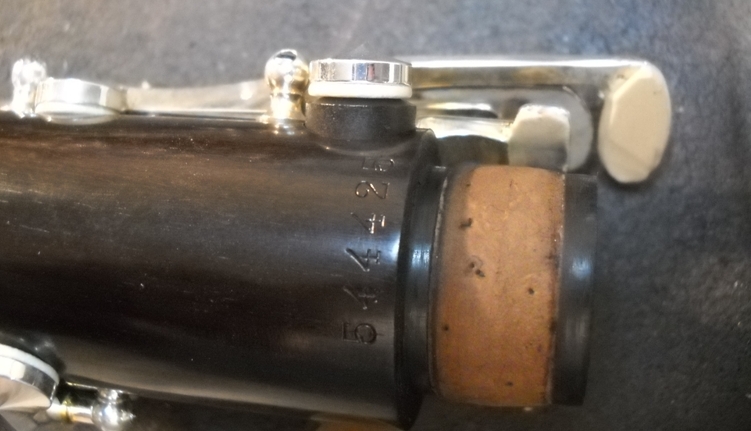
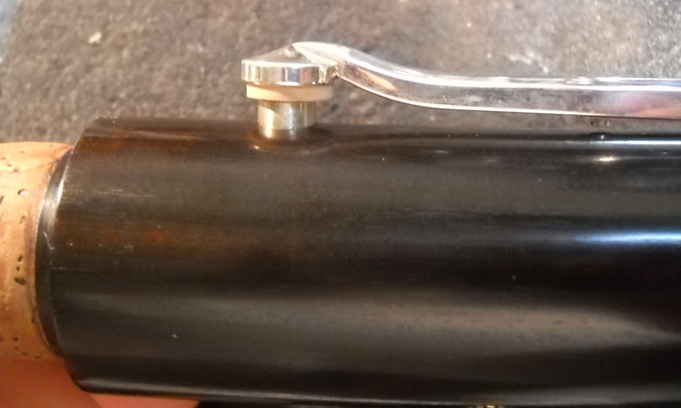
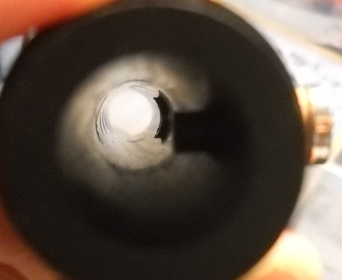
R-13 PrestigeBb Model: BC1133L-2-0, 2011 Retail $8,355.00
grenadilla only
A Model: BC1233L-2-0*, 2011 Retail $8,800.00 grenadilla onlyFrom wwbw.com
capture his or her unique expression.
Buffet Crampon Prestige R13 Professional Bb Clarinet
The wood of the Prestige R13 is carefully chosen for its acoustic and
aesthetic qualities and therefore remains unstained. The undercutting of each
tone hole is carried out according to Buffet Crampon’s top-of-the-range
stringent standards. The upper and lower joint tenons come with metal rings
which reduce the risk of cracks. The keywork is carefully tried, tested, and
adjusted by expert craftsmen to work perfectly. The models have Gore-Tex pads,
an adjustable thumb rest, and an Eb / Ab lever as standard. The 13 Prestige
has a powerful sound and a focused and flexible tone in all registers.
Order today with the no-risk assurance of our Total Satisfaction and
Low Price Guarantees!
- Level: Professional
Key: Bb
Barrel, Body, and Bell Material: Carefully selected, unstained grenadilla
Keys: Silver-plated
Key System: Boehm (French) / 18 Keys
Special Keys: Alternate Eb/Ab lever
Tone Holes: Undercut
Bore Shape: Polycylindrical
Bore Size: .574″ (14.59mm)
Pads: Gore-Tex
Springs: Blue steel (French)
Includes: Deluxe case, mouthpiece, ligature, cap, and care products
Crafted In: France
- Level: Artisan
- Key: A
- Body, Barrel, and Bell Material: Carefully selected, unstained grenadilla
- Key Material: Silver-plate
- Key System: Boehm (French) / 18 keys
- Special Keys: Auxiliary Eb lever
- Tone Holes: Undercut
- Bore Shape: Polycylindrical
- Bore Size: .576″ (14.64mm)
- Pads: Gore-Tex
- Springs: Blue Steel
- Includes: Case, mouthpiece, ligature, cap, and care products
- Crafted In: French
R13 Prestige has the following options
- Hand selected wood (versus the regular R13)
- silver plated keywork
- left pinky Eb key
- R13 Prestige plaque
- notice the plastic screw on the G# key
FestivalBuffet’s website
Three international renowned artist Jacques Lancelot, Guy Deplus and Michel
Arrignon collaborated to produce the Festival clarinet.
It meets the needs of today’s musicians and teachers who are faced with the
difficult task of interpreting a wide repertoire of works from Mozart to Boulez.
Musicians will certainly appreciate its depth of sound, which is particularly
warm.
The tone and precision of this instrument are in perfect harmony.
The Festival belong the R13 bore family and has a rich powerful fluid tone.
Below are pictures of a Festival A Greenline Clarinet. Notice the green
dots on the back of each segment identifying that it is a Greenline.
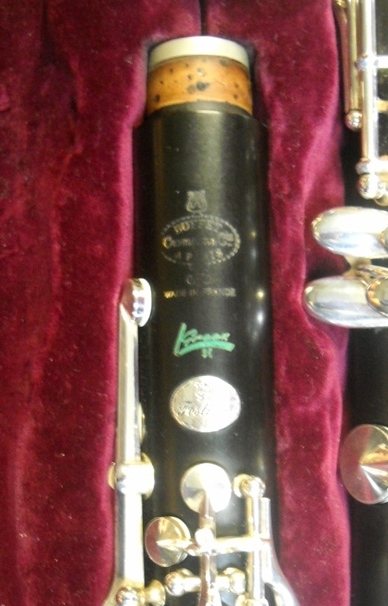
ToscaBb Model: BC-1150GL-2-0, 2011 Retail price of $9,820.00
(available in Greenline & “Premium” Grenadilla)
A Model: BC1250L-2-0, 2011 Retail price of $10,255.00
(available in Greenline & “Premium” Grenadilla)From wwbw:
The ultimate in sound quality, intonation, and pure tone. Buffet Crampon Tosca Bb Clarinet The Buffet Crampon Tosca was created in a collaborative effort between Buffet Crampon craftsmen and artists such as Michael Arrignon, Romain Guyot, Pascal Moraguès, Guy Deplus, and Paul Meyer. The result is a clarinet with incomparable style and elegance expressed in the finest woods, advanced materials, and most precise manufacturing techniques. It has a warm, velvety sound and extremely consistent intonation at either 440 or 442Hz as is provided by two barrels. The keywork is built for comfort and speed. It sports a low F correction key to better match instruments holding down the low end of the ensemble. Gore-Tex and cork pads, and select grenadilla or Green Line bodies.
Level: Artisan Key: Bb Pitch: 440/442 (2 Barrels) Barrel, Body, and Bell Material: Premium Grenadilla or Green Line Composite Key: Silver-plated Barrel Size: 66mm and 65mm Special Keys: Eb Lever, Low F correction Tone holes: Undercut Pads: GT Includes: Case, mouthpiece, ligature, and care products Crafted In France
- Level: Artisan
- Key: A
- Pitch: 440/442 (2 Barrels)
- Barrel, Body, and Bell Material: Premium Grenadilla or Green Line Composite
- Key: Silver-plated
- Barrel Size: 66mm and 65mm
- Special Features s: Eb Lever, Low F correction, Raised C#/G# tone holes
- Tone holes: Undercut
- Pads: Gore-Tex
- Includes: Case, mouthpiece, ligature, and care products
- Crafted In France
The Tosca has many unique features, such as:
- a unique, ergonomic register key
- uniquely sculptered trill key touches
- C key rod adjustment screw
- low F correction key
Aguste Buffet introduced the post installed needle spring
in 1837 see http://www.jlpublishing.com/ClarinetHistory.htm
Keywork Trivia only the Buffet mafia will love (post
installation and touch piece screws)
Below is an early 1900s Buffet with a wrap around register
key. The posts were simply screw in. This provides a tight
foundation but as the threads or wood compress a bit it can become loose.
Even a little lose may, when no keywork is on, show that the post when
tightened is no longer in parallel adjustment to the other posts.
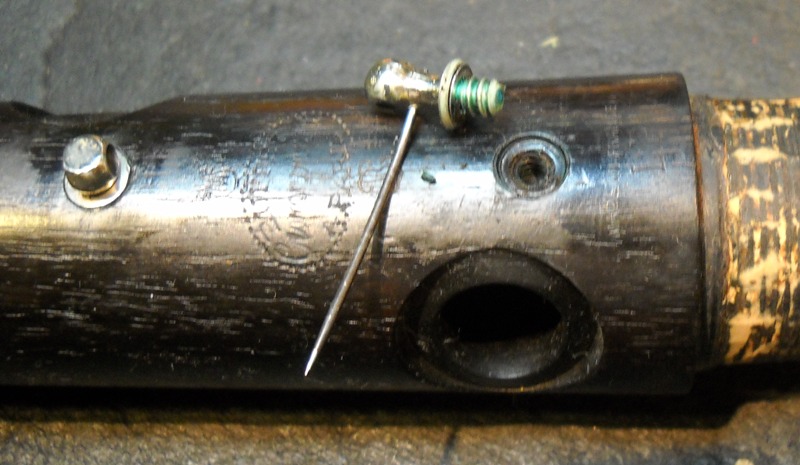
Post installation evolved over time. This 1959
Buffet the post itself screwed in and there was a wood screw to maintain
it’s angle – the post has the flush screw-in extension.
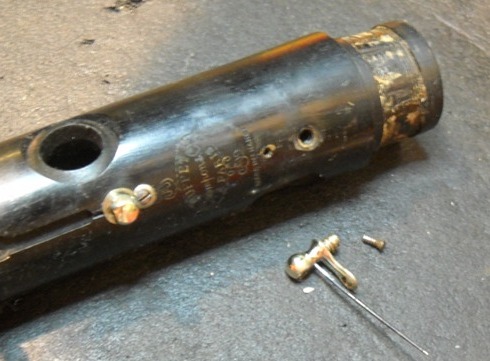
The picture below of a 1968 Buffet shows that the post
is a plug that is pushed into the body with a tightening wood screw.
Flat / Needle Spring Information
Flat Springs versus needle springs
One can only really theorize that in the 1800s it was much
easier to install a flat spring than a needle spring. It’s easier to
drill a hole through a key for a long screw to hold a flat spring, then
just grind and buff (thus the reason in early Buffets you see the screw on
the top piece). Needles on the other hand, back then could be harder
to drill a small hole in a small post. Try this yourself with crude
instruments and you may concur.
In the below picture of a late 1800s Buffet Albert you can
notice the use the flat springs on the UJ Eb sliver key, the C#/G#, LJ
sliver F# key and of course the trill keys etc. There were only a couple
needles used on the ring keywork.
Below picture shows an early wrap around Buffet (1898)
with a flat spring on the lower spatula key. This, of course, was
later replaced with a post needle spring. You can also see the plug for
the needle spring to rest against on the body. The early Buffets also had
flat springs for the C#/G#. (trivia …. some 1960s – 70s Selmer USA
Signets used needle springs on the throat A key)
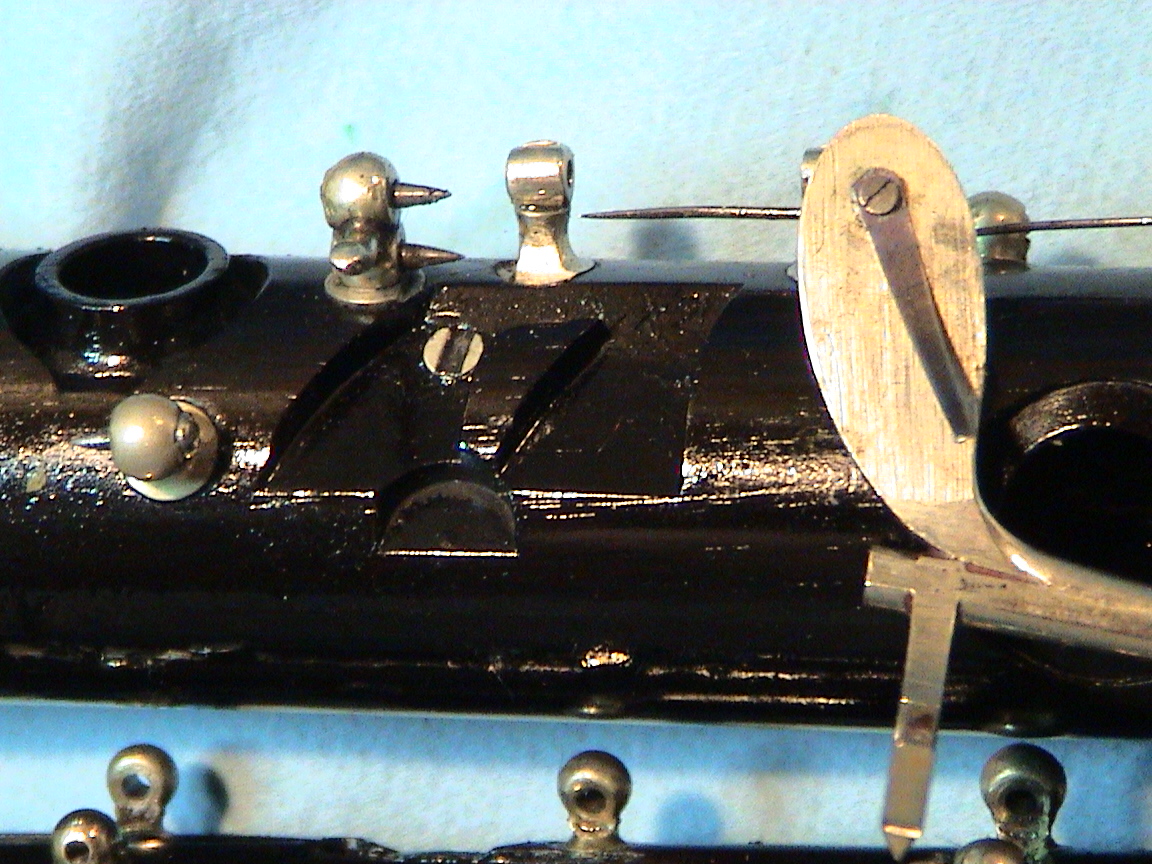
And on really early clarinets the toneholes were not as tall as they are
now. They evolved. In the picture below you can see that the
tonehole isn’t higher than the surrounding body itself. They are cut
with a “gap” for the ring but the sides of the tonehole drop off.
You can also see on the Ab and Eb key the screw holding the flat spring in
that was cutoff and grinded/buffed down.
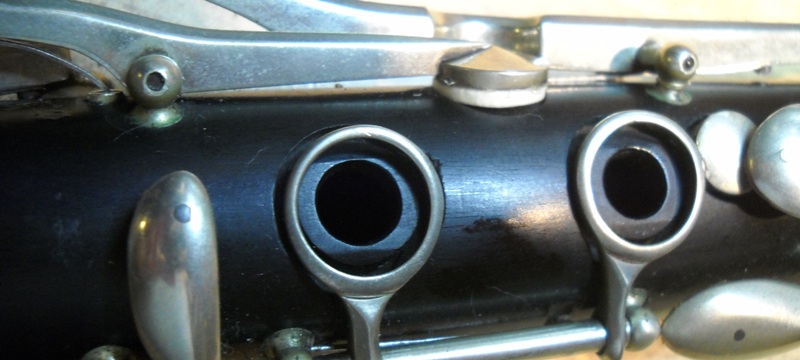
The throat key evolution from 3 posts to 2 sets of 2 individual
posts can probably be attributed to improving the throat Ab key.
With the 3 posts the top post of the Ab key usually was not too
far equal to the midway point of the throat A key padcup. In order to
accomodate a longer spring to make this key work better one has to either move
the top post up, in which case it would look really strange as it would stick
out, or lower the lower post, thus creating independent posts.
This wasn’t a new idea. I believe Selmer Paris, Malerne,
Noblet all had done this same thing previously. Thus it was simply a
copied idea.
In the early 1970s such as 1974 era of R13’s Buffet introduced
the wavy tenon. This went mostly visually unnoticed to customers but to
technicians it posed a significant problem.
The tenon, at least initially conceptually is a good idea, of
course that concept elludes me right now.
The end result was that the joint ended up being wobbly.
And when the technician went to replace the cork most could not do it properly.
After all, who has wavy cork?
The only good long term solution is to cut down that wavy tenon
and making it flat.

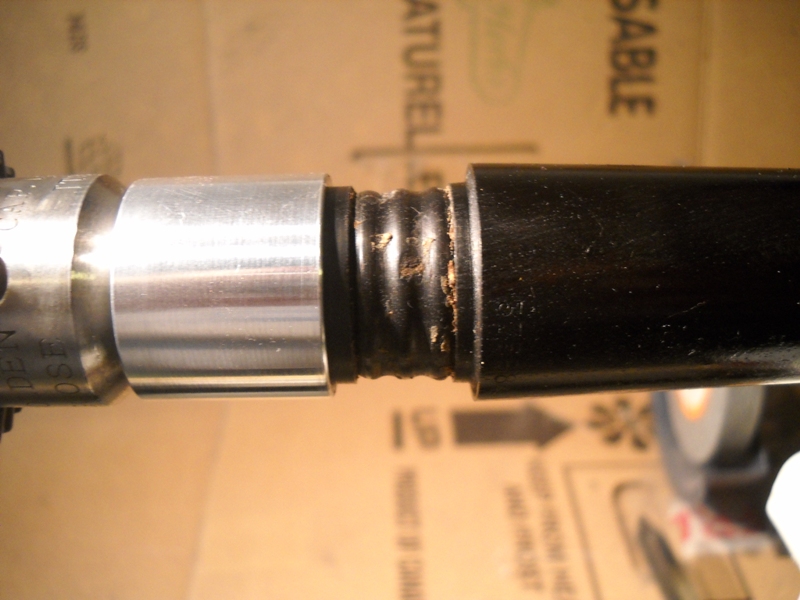
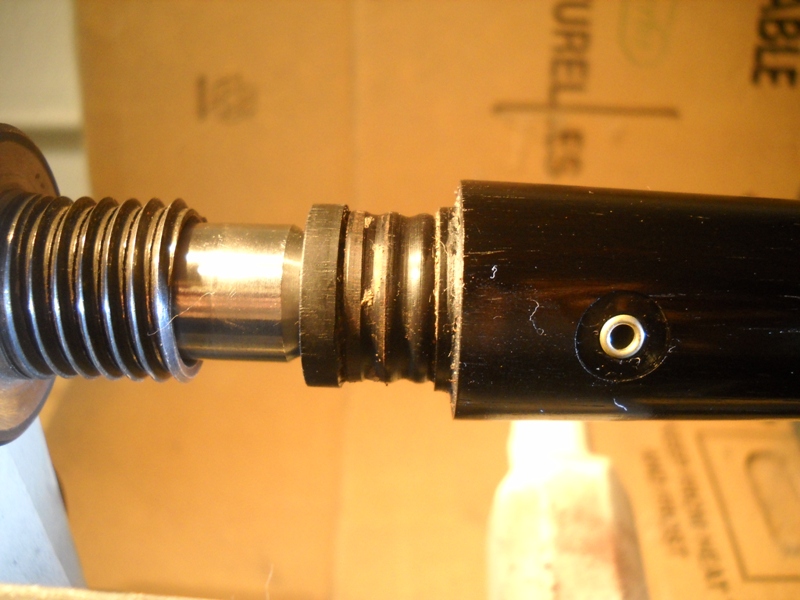
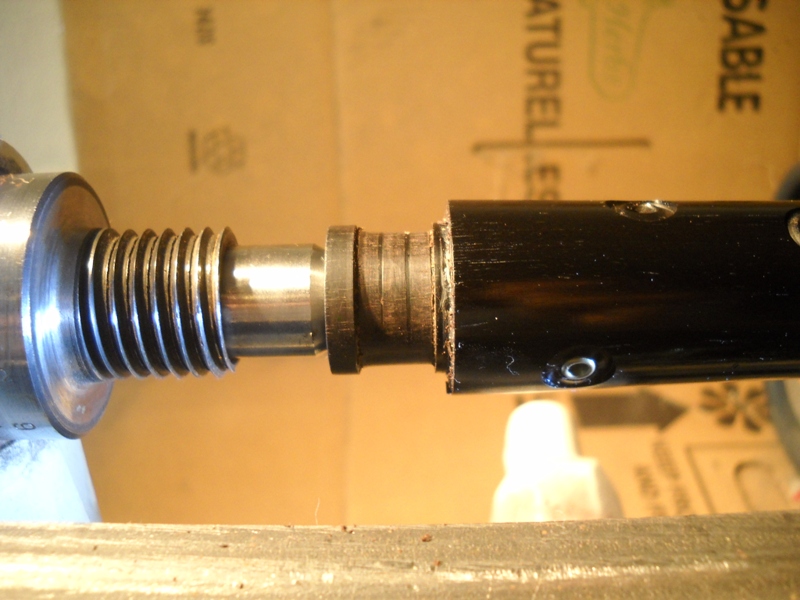
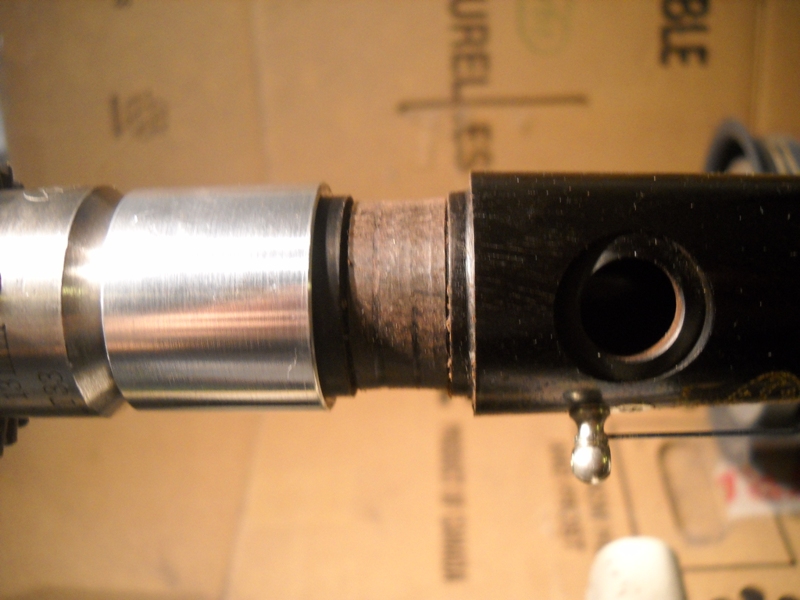
Difference Between Models
So what’s the difference between a R-13 and a BC-20/RC or
S-1 or other models. From time to time I’ll take measurements of
various attributes and post them here
Comparison between late 1950s R13 and a late 1960s BC-20
(RC model)
| R-13 | BC-20 | |||
| UPPER JOINT | distance from top of joint (minus tenon) and middle of tonehole |
Diameter of tonehole / diameter of overcut of tonehole | distance from top of joint (minus tenon) and middle of tonehole |
Diameter of tonehole / diameter of overcut of tonehole |
| top ring | 5.20 / 5.65 | 115.00 mm | 4.98 mm / 5.30 | |
| 2nd ring | 6.60 / 6.85 | 147.80 | 6.57 / 6.84 | |
| C/G tonehole | 7.55 / 7.75 | 171.60 | 7.68 /8.08 | |
| LOWER JOINT | ||||
| top ring | 7.90 / 8.25 | 38.50 | 8.09 / 8.38 | |
| 2nd ring | 7.35 / 7.61 | 64.50 | 7.75 / 8.00 | |
| lower ring | 8.85 / 9.15 | 87.60 | 9.40 / 9.60 | |
November 2012 – Buffet
Model Changes
Below pictures are from the
www.Buffet-Crampon.com website taken on Nov 20, 2012
PROFESSIONAL
|
Bb
Professional
|
Bb
Professional
|
A
Bb
Professional
|
|
Bb
A
Eb
Professional
|
Bb
A
D
Eb
C
Professional
|
Bb
A
Professional
|
|
Bb
A
Professional
|
Bb
A
Professional
|
Bb
A
Eb
Professional
|
|
Bb
A
Eb
Professional
|
Basset A
Alto
Contra-alto
Basset horn F
Professional
|
PERFORMANCE
|
Bb
Performance
|
STUDENT
|
Bb
A
Student
|
C
Eb
Student
|
Bb
Student
|
|
Bb
Student
|










































